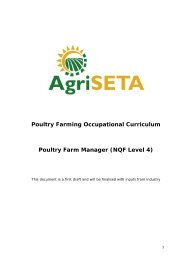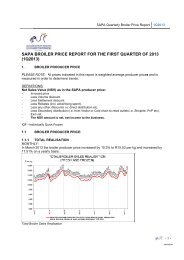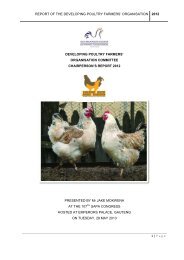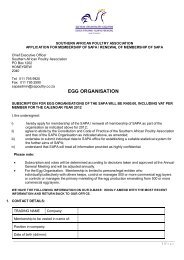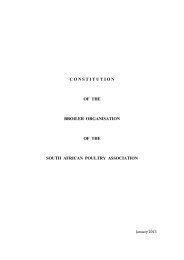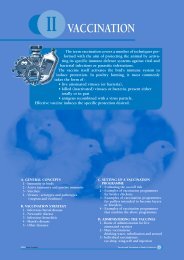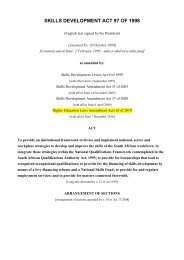POULTRY ASSOCIATION OF ZAMBIA
POULTRY ASSOCIATION OF ZAMBIA
POULTRY ASSOCIATION OF ZAMBIA
- No tags were found...
You also want an ePaper? Increase the reach of your titles
YUMPU automatically turns print PDFs into web optimized ePapers that Google loves.
<strong>POULTRY</strong> <strong>ASSOCIATION</strong> <strong>OF</strong> <strong>ZAMBIA</strong>COUNTRY:<strong>ZAMBIA</strong>BROILER INDUSTRY:YEAR: 2012QuarterAVERAGENETT DAY OLDBROILERCHICKPLACEMENTSPER WEEK(add importsand subtractexports)AVERAGEWEEKLYBROILERPRODUCTION(slaughterings)AVERAGEWEEKLYBROILERPRODUCTION(live sales)*JAN – MAR 1,035,000 420,000 563,250 14.87APR – JUN 1,035,000 500,000 483,000 14.87JUL – SEP 1,250,000 500,000 690,000 15.45OCT – DEC 1,700,000 800,000 815,000 16.70YEAR 1,255,000 555,000 637,812 15.47*AVERAGEPRODUCERPRICE NETREALISATION(PER KG)CURRENCY USED:Rebased Zambian Kwacha (ZMW)RECENT DEVELOPMENTS:In 2012, the country closed the year with an annual broiler production of 65million. Increased production of poultry has been riding on major factorssuch as restriction of imports, higher consumer demand, high prices of beef,pork and fish and above all government support. Compared with the rest of thelivestock sector, the poultry industry in Zambia has become more scientific, betterorganized and continuously progressing towards modernization. Breeding and feedingmanagement has improved through education, training, competition, expansion andsurvival instincts.
The projected capacity of the poultry industry indicates a positive future forthe sector. Fair internal competition between domestic producers in thedomestic market will continue and this will definitely strengthen the market inthe future.The poultry industry though posting positive growth in Zambia has experienced achallenging business environment. The major challenges being experienced include;higher costs of major feed raw materials, expensive fuels, poor or lack adequatelegislation and regulations and the energy crisis. Government has indicated that theywant to create numerous job opportunities over the next 10 years to reduce youthunemployment to manageable levels. The poultry industry is well positioned to assistGovernment achieve this goal on a sustainable basis. Making everything equal, theindustry will create additional 5,000 sustainable job opportunities in the next fiveyears as poultry consumption continues to increase. The industry is posed to fulfillthis new domestic demand by continued lobbying of Government support forincreased poultry production, boost the development of genetics and improve thequality of the products to meet the demand of the domestic market.CONSUMER CONSUMPTION TRENDS:The poultry industry continues to dominate the livestock sector in Zambia, and is themain supplier in kilogram and protein terms, as currently more poultry products areconsumed per annum than all other animal protein sources combined. Poultry hasshown an upward trend in consumption over the past decades. Consumption ofpoultry meat grew by 22% in the same year compared to consumption of beefand pork. The per capita consumption of meat 3.6 kg a decade ago to 12 kg in 2012.In short, this stimulated growth in consumption of poultry meat is a major victory forthe industry as poultry has remained the preferred meat.INDUSTRY TRANSFORMATION:Vertical integration has become the major option by all the big investments in thiscountry to ensure the safety and quality of products from farm to folk. The localindustry now fully controls the breeding of poultry, food production, slaughter,processing, packaging, distribution and logistics to ensure and assure high levels ofproduct traceability. This has enabled the sector to make many investments over therecent decade making poultry the most valuable livestock subsector in Zambia.
EGG INDUSTRY:YEAR: 2010QuarterJAN – MARAPR – JUNJUL – SEPOCT – DECYEARNUMBER <strong>OF</strong>POINT <strong>OF</strong> LAYSPLACEDASVERAGELAYING FLOCKIN LAY40,461 1,435,000 16.0065,000 1,875,000 17.5075,000 2,670,000 17.5080,000 2,880,000 18.5065,115 2,215,000 17.38AVERAGEPRODUCER PRICEPER TRAY(AVERAGE <strong>OF</strong> ALLSIZES)CURRENCY USED:Rebased Zambian Kwacha (ZMW)RECENT DEVELOPMENTS IN PRODUCTIONIn 2012, the country closed the year with an annual layer production ofslightly above 4 million. Increased production of eggs has been riding on majorfactors such as restriction of imports, higher consumer demand due growinghospitality industry and above all government support. The projected capacityof the poultry industry indicates a positive future for the sector. Fair internalcompetition between domestic producers in the domestic market will continueand this will definitely strengthen the market in the future.The pullet day-old chicks are supplied mainly by two hatcheries in Zambia. Inaddition, approximately 10% of the chicks are imported, and the largest consumer ofimported day old layer pullets is Golden Lay Farm whose requirements are beyondthe capacity of the local producers. Pullet chicks are usually imported if the singlerequirement is larger than the local hatcheries are able to hatch at that particulartime. This sector is dominated by large scale producers who constitute 70% of thetotal layer productionCONSUMER CONSUMPTION TRENDS:The per capita consumption of eggs has grown from 28 eggs respectively a decade agoto 52 eggs in 2012. In short, this stimulated growth in consumption of poultryproducts is a major victory for the industry as poultry has remained the preferredanimal protein source. Considerable scope exists for an increase in per capitaconsumption, particularly taking into account the price competitiveness of eggs as aprotein source compared to other animal proteins.
<strong>POULTRY</strong> INDUSTRY DISEASE AND ANIMAL HEALTHThe country has put much emphasis on disease surveillance and control in order tokeep disease incidences to minimum in breeder, layer and broiler operations. Zambiahas a unique status as being free of Avian influenza (bird flu), experiences lowincidences of outbreaks of Newcastle Disease and Infectious Bursal Disease (IBD)which routinely cause massive losses in native and farmed bird flocks elsewhere. It isa status that PAZ and its members continue to seek to protect.Salmonella and campylobacter in chickens is constantly checked by the Departmentof Veterinary Services. Salmonella routine surveillance and testing is mandatory inall breeder farms and hatcheries, large scale operations and poultry abattoirs.No major disease outbreaks of concern have been reported in the past year butemphasis has been placed on strict precautionary measures, disease surveillance andcontrol, all in order to maintain a low disease incidence in the sector.<strong>POULTRY</strong> INDUSTRY IMPORTS AND EXPORTSThe annual poultry imports for 2012 into Zambia were insignificant in comparisonwith the total poultry imports for 2011. Broiler meat accounted for less than 5% of allpoultry imports, the balance largely being further processed products from RSA.Poultry exports operate from a very low base. Zambia is currently exporting day oldbroiler chicks and fertile eggs to Congo DR, Tanzania and Kenya.Poultry exports operate from a very low base. Zambia is currently exporting tableeggs to DR Congo only. With expanding local production and reduction in localconsumption, marketing is posing a big challenge hence there is need to continuesearches for new external markets to allow any possibility of capitalizing.<strong>POULTRY</strong> INDUSTRY INPUT COSTSFeed prices have increased steadily over the last two months despite pricefluctuations not yielding an increase in the prices of poultry products. Feed costsalone contribute about 75% in egg and broiler productions. This may discouragemany farmers to increase the stocks of commercial broilers on their farms due topoor demand and uneconomic prices for the products. Such fear may contributenegatively to the overall performance of the industry in the first quarter of 2013.Because of high cost of feeds and low prices of products, profitability of poultryfarming in the country has declined by an average of 2.5% and if allowed to dropfurther it will negatively affect the financial condition of the poultry industry. Theindustry’s average return on sales is expected to decrease from 15.6% in 2012 to 13.1% in 2013, which may negatively impact on the investment attractiveness of the
industry and potentially, this trend could reduce the rate of development of thepoultry industry in the country.The increased production costs related to the increased costs of feed ingredients hashad a significant impact on egg producer costs. By October 2012, the increased feedingredient costs were accounting for an additional 3 % monthly to costs of eggproduction. The cumulative effect from October, 2012 through to February, 2013 isabout 12%. The cyclical changes in consumer demand and the forecasted henplacement for the second half of 2012, combined with the rising feed prices, are goingto put egg producers under pressure and will erode the gross margins seriouslyultimately affecting production levels.The rise in the demand for maize and soybeans for human consumption has becomean important factor in the increased feed costs experienced by all sectors of thepoultry industry. The increased costs in feed ingredients have resulted in highcumulative costs for egg and broiler producers during the past 4 months puttingpressure on poultry producers' costs and profitability numbers hence making feedingefficiencies even more important.CONCLUSIONThe Zambian domestic market still remains small for the expanding production. Withmacro stability largely within reach, expansion of poultry exports will be the solution.This will sustain the production base and create more employment opportunitiesnecessary to make a marked reduction in poverty.While effective export promotion requires a dynamic poultry sector, a dynamic andcompetitive poultry sector cannot flourish if it produces only for a small domesticmarket. Accordingly, the poultry industry is restructuring and reforming with focuson increasing value addition and diversifying poultry production.There is potential for much more export diversification particularly in sectors suchpoultry breeding and poultry processing but these opportunities requires arefocusing of the reforms in a more comprehensive and consistent policy package soas eradicate the binding constraints to the poultry export promotion.



